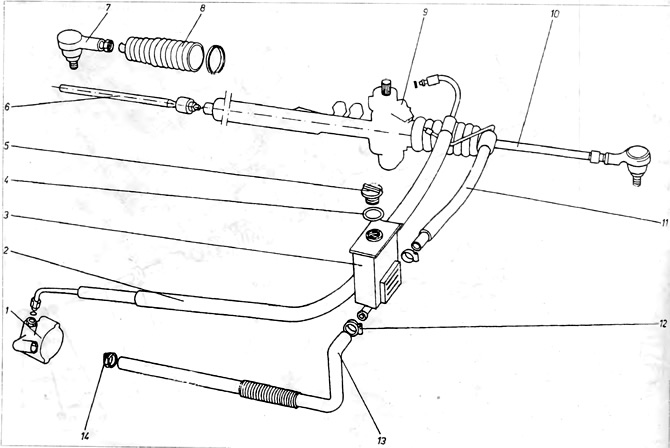Steering rod replacement
1. Remove the steering gear assembly from the vehicle along with the steering rods to avoid damage to the gears and transmission pinion. Details regarding disassembly are given in point 9. In addition, the supply pipes must be disconnected and protected from contamination.
2. After removing the steering gear, it is necessary to clean the outside, then release the clamps and remove the steering rod covers from the internal hinges 8 (fig 9.7).

Pic. 9.7. Power steering
1 - pump; 2 - pipeline under pressure; 3 - oil tank; 4 - gasket; 5 - oil tank plug; 6 - right steering rod; 7 - external ball joint; 8 - steering gear casing; 9 - steering gear; 10 - left tie rod; 11 - return pipeline; 12, 14 - clamping belts; 13 - suction pipeline.
3. Clamp the steering gear rack in a vice with soft cheeks.
4. The tie rods and outer ball joint can be removed in the same way as in a non-powered steering system.
5. Wrap the steering rods on the rack and adjust certain distances as described
6, Install the steering gear and tie rods as described in point 9.
Adjustment
8. Remove the steering gear.
9. Loosen the safety nut of the adjusting bolt. then screw in the adjusting bolt until the toothed rack can still move without jamming or jamming. Tighten the safety nut.
10. Install the steering gear in the car.
Checking the oil level
11. The oil level in the booster system is checked with the front wheels installed for straight driving and with the engine running. Check if the oil level in tank 3 is between MAX and MIN. If necessary, raise the level using only ATF oil.
12. If there is a need for constant topping up of oil, it is necessary to check for oil leaks near the pump, on the piping connections to the tank and steering gear.
13. To drain the oil from the amplification system, it is necessary to disconnect the suction pipe 13 from the pump 1 and drain the oil into a vessel. While draining the oil, it is necessary to turn the steering wheel from one extreme position to another in order to remove as much oil as possible.
14. After draining the oil, reconnect the suction line to the pump, then fill the tank with new oil. Start the engine and immediately when it starts to work, turn it off. This must be repeated several times in order to cause the oil to be rapidly drawn into the system.
15. Monitor the oil level and top up immediately so that the tank is never empty. When the oil level stops dropping as a result of repeated starting and shutting down, the engine should be allowed to idle.
16. Turn the steering wheel several times from one extreme position to another. At the same time, it is necessary to pay attention to the fact that the wheels do not stop in the full turn position, as this can cause an increase in pressure in the system.
17. It is necessary to constantly monitor the oil level in the tank, replenish it in order to keep the level near the MAX designation.
18. When the oil level stops falling and no air bubbles appear in the reservoir, turn off the engine and put on the tank funnel cap. When the engine is turned off, the fluid level will rise slightly.
19. If there is a suspicion that the pump is not working properly, it is necessary to have it checked at a service station. The pump assembly is not inspected and repaired. If the pump is defective, it must be replaced with a new one, like the entire assembly.
20. To remove the pump assembly, the system must be drained.
21. Disconnect the pressure line from the pump assembly.
22. Loosen the pump assembly mounting bolts and rotate the pump so that the drive belt can be removed from the pulley.
23. Hold the pump, remove the fixing bolts and remove the pump assembly.
24. Installation is carried out in the reverse order to dismantling. In this case, it is necessary to tighten the drive belt, fill the system with oil and remove air from it.
Drive Belt Tension Adjustment
25. To adjust the drive belt tension, the nuts and bolts securing the pump assembly must be loosened. Also loosen the locknut of the tensioner bolt on the pump bracket. Turn tensioning bolt until until the belt can be bent about 10 mm under strong thumb pressure halfway between the pump pulleys and the engine crankshaft. When the belt tension is normal, it is necessary to tighten the locking nut of the adjusting bolt. Tighten also the fixing nuts and bolts of the pump.

Visitor comments